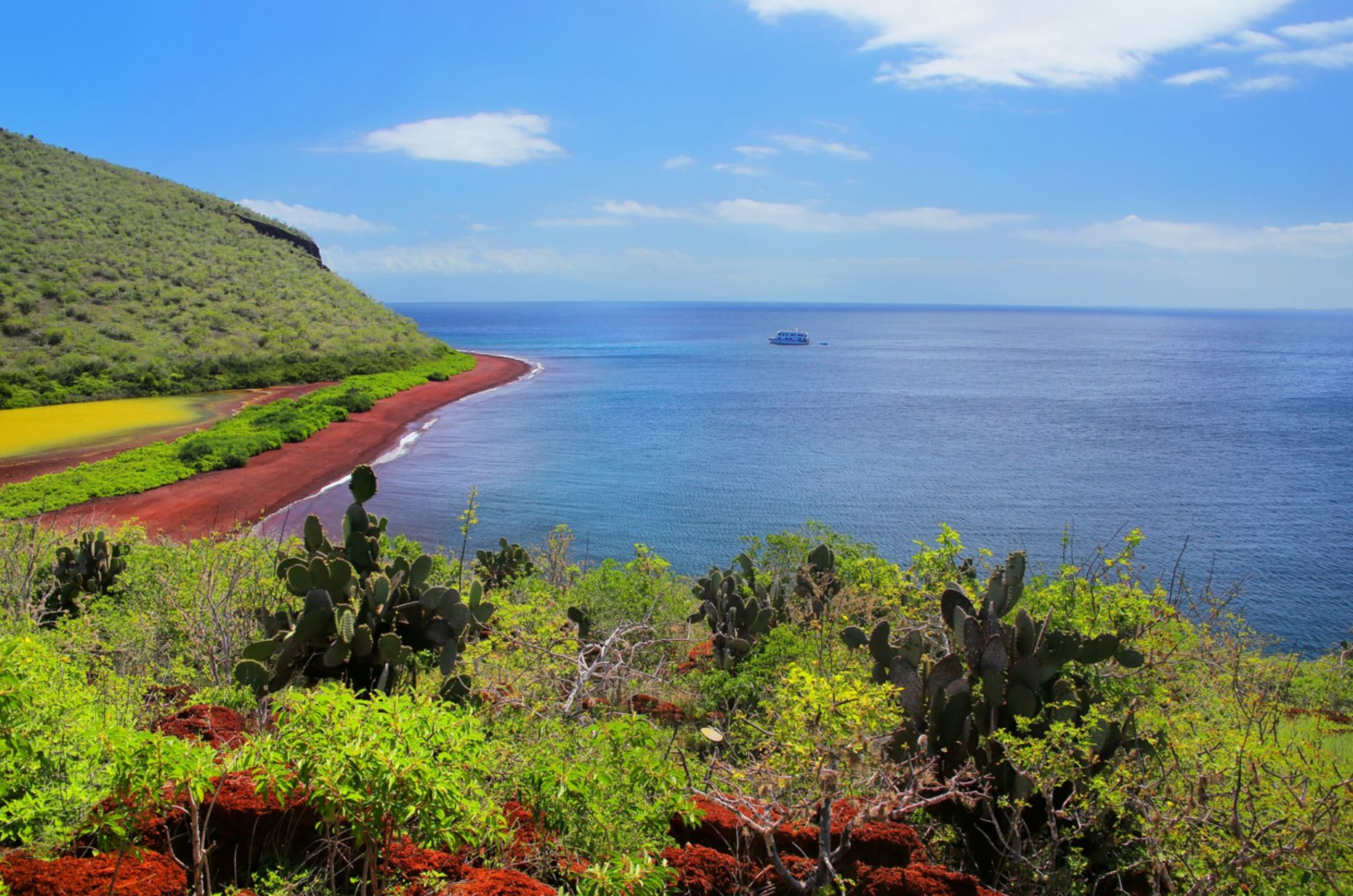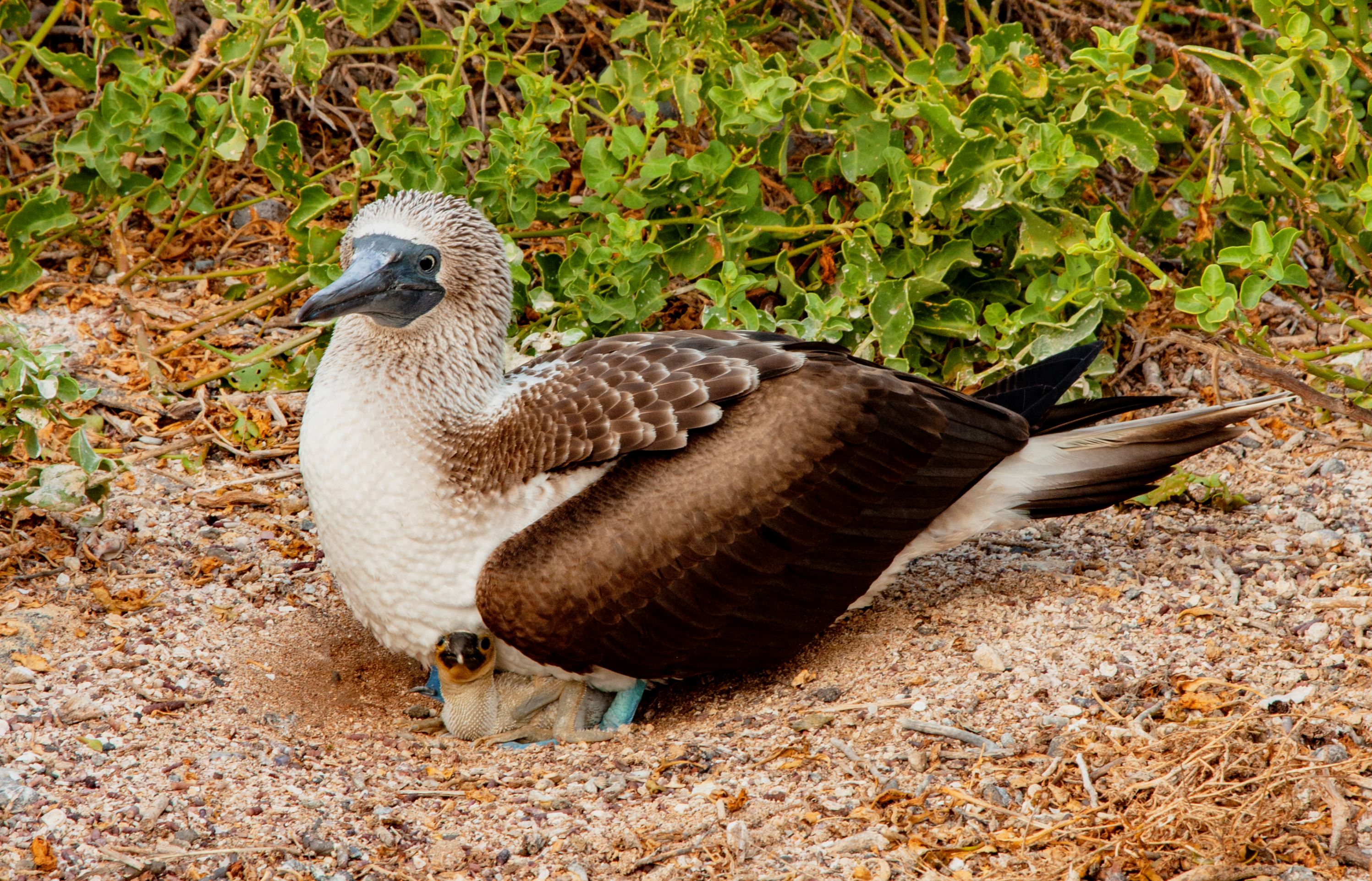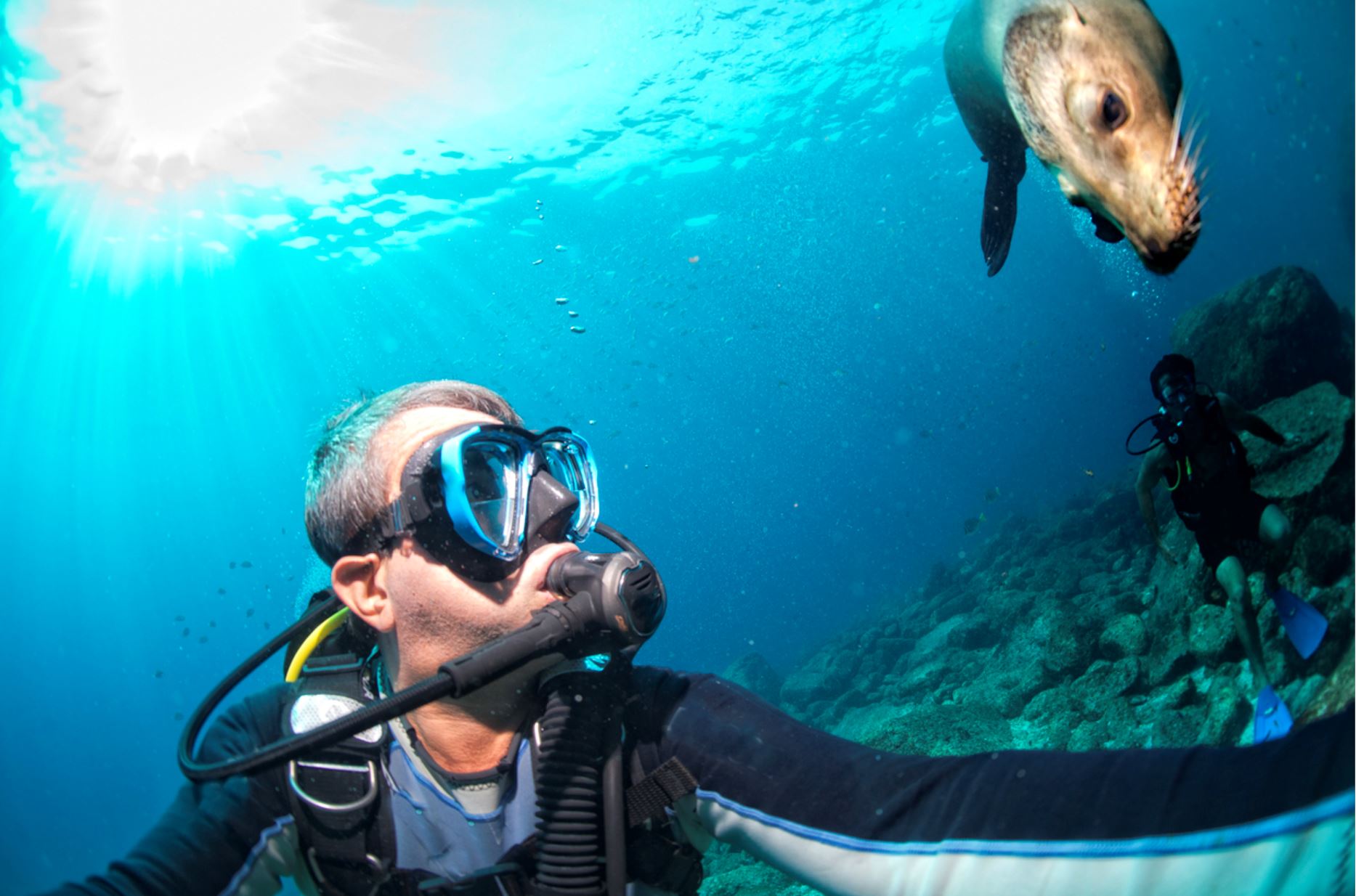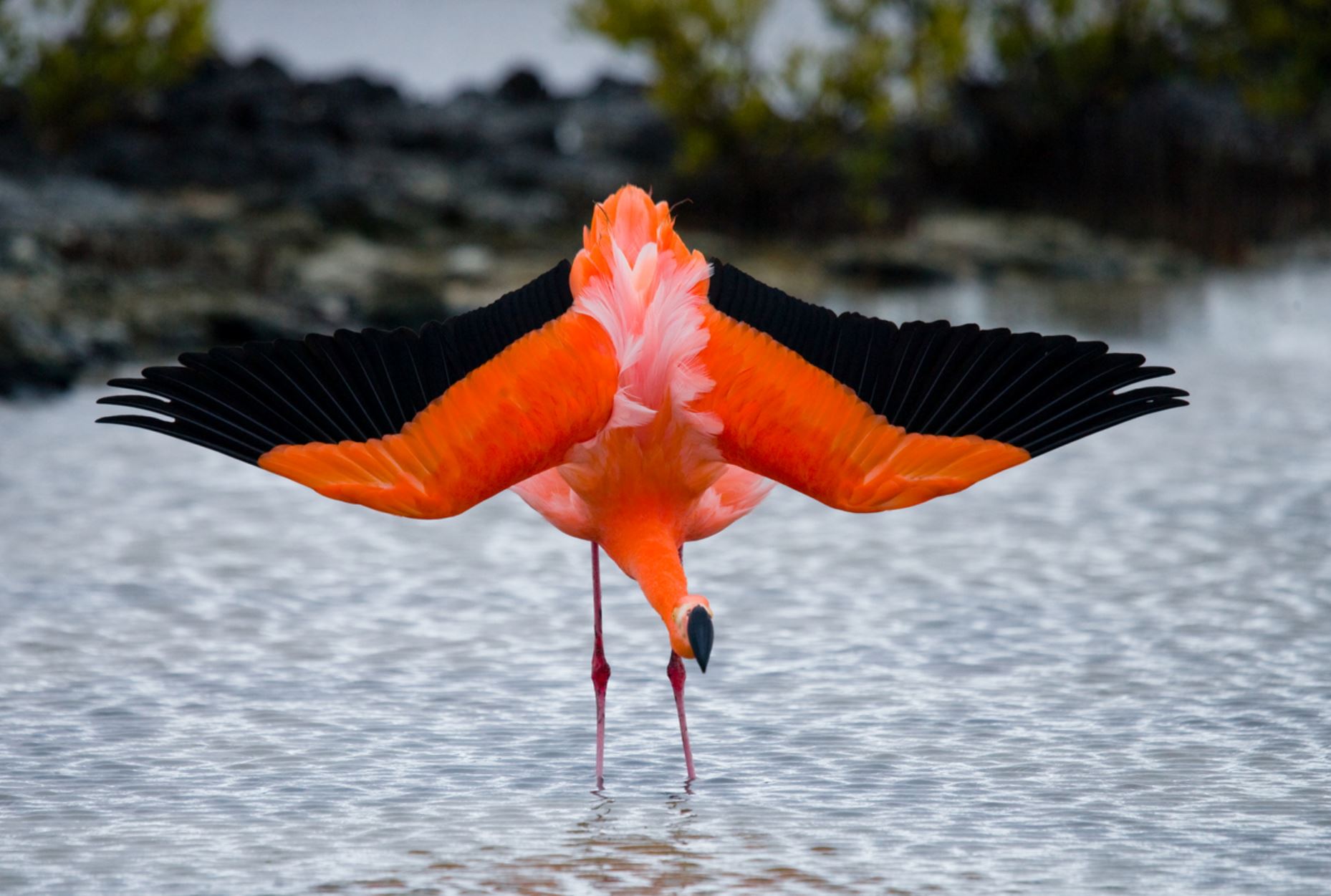Rábida
Animals/Wildlife




Landscape/Views




Snorkeling



Beaches



The red island: Result of the oxidation on the moment of its formation this island offers red landscapes with small craters, cliffs and a red beach. Here, hundreds of sea lions formed a settlement together with a nesting colony of pelicans. Flamingos in the back inhabit a small salty lagoon. Rabida is an unpopulated island.
A red sand beach with a large sea lion colony, Palo Santo forests, endemic cacti, and the only Galapagos site where the nine Dawin’s finches are found.
Also known as Jervis Island in English, Rabida is one of the most diverse in terms of volcanic activity as it lies at the very heart of the archipelago’s volcanic origin.
It is an island comprised of lava poured out of scoria cones, which are very rich in iron oxide and magnesium (typical of Galapagos basaltic lava); that when exposed and as it rusts, gives the island its astounding, unearthly reddish color.
Visitor sites
A walk a long the fantastic red beach and snorkeling.
Rabida in itself has an abundance of landscapes and marine life. The trail for visiting the site is somewhat short, requiring about 45 minutes of walking. We can also go around the shoreline in a dinghy to spot fur seals, pelicans, blue-footed boobies and Nazca boobies.
Excellent place for swimming and snorkeling, you could see white tipped sharks, rays and sea lions, and other different species.
- Activities: 1 hour 30 min hike / 1 hour snorkeling / 1 hour dinghy ride
- Highlights: In this deep red beach, surrounded by cliffs and steep slopes of volcanic cinder cones, we will find a noisy colony of sea lions. The island is a birdwatcher’s delight.
Pictures
Highlights / Places to Visit
walking thru de fantastic red beach from Rábida island
Animals that can be seen on the island
Blue-footed booby
The blue-footed booby is native to the tropical regions of the Pacific Ocean and is part of the six species of boobies. There are about six thousand blue-footed boobies in the Galapagos, typically nesting on the rocky shores and cliffs of the islands. Half of the world’s population live in the archipelago.
Their clumsiness on the ground, lead the bobby to be named by the Spanish “bobo,” which means silly or stupid. The blue-footed booby has an aerodynamic shape and the extraordinary binocular vision make it one of the best fishing birds. It breathes by the corners of its beak and their nostrils are permanently blocked as they dive to feed. They can reach the speed of 90kmh (60mph) diving in water, and they can go down to depths of 25m (82ft).
In males, the brighter the blue color of the feet, the more reproductive success they may have. Female boobies lay between two to three eggs a year, creating high competition between the offspring and resulting in one survivor that portrays natural selection in every generation. Both take care of the nest for about 45 days and feed the chicks together, by regurgitation for approximate two months.
The boobies are opportunistic breeders, preferring the cold season to mate (June-August). Overall, they tend to be monogamous and their courtship ritual is one of the most entertaining to witness. The male offers a present, usually a rock or a branch, and then dances in front of the female showing the feet and making noises while standing with the beak up high and the wings wide opened with tips to the sky.
Males and females are very similar, differences are that females are slightly bigger and have a larger eye pupil.
- Animal Group: Seabirds
- Scientific Name: Sula nebouxii
- Animal Average Size: 81 cm
- Animal Average Weight: 1.5 kg
Where can you find with a little bit luck the blue footed booby in Galapagos:
Rábida island
Isabela island
Santa Cruz
North Seymour
Floreana
Darwin´s finches
Darwin finches are a group of about 14 birds that gained notoriety when Charles Darwin studied them back in his voyage with the HMS Beagle in 1835. Darwin arrived in the Galapagos and was fascinated by collecting species he found in his trip — the species were taken back to the UK for further studies.
Back home, Darwin studied the birds with ornithologist John Gould and found fascinating similarities between these birds and a common South American ancestor finch. They noticed that finches had slight differences in the beaks and were also as a whole different from the original continental ancestor. Each finch had adapted to their own island environment and food source availability with variations in their claws, size, and beaks — deriving from this they were acknowledged as endemic to the Galapagos Islands.
Some finches have adapted to eat insects, others to eat nuts, others are completely vegetarian. Charles Darwin, years later, gathered all his findings in his famous book On the Origin of Species and concluded that species have the ability to change throughout time making favorable adaptations to their environment and becoming new species. This is what we commonly know as the theory of evolution by means of natural selection.
- Animal Group: Landbirds
- Scientific Name: Geospizinae
- Animal Average Size: 10 - 20 cm
- Animal Average Weight: 8 - 38 g
Places where you may see this animal:
Isabela
Santiago
Rábida
Santa Cruz
San Cristobal
Española
Galapagos Dove
One of the more attractive and pleasant birds to encounter on the islands is the Galapagos Dove. The Galapagos Dove is a tame and well-mannered creature. It is reddish brown with black and white markings, touches of incandescent green, red feet and a bright blue eye ring. The Galapagos Dove grows to measure between 18 and 23 centimetres long. Its beak is curved downward, larger and more curved than most other doves.
The Galapagos Doves curved beak helps it feed mainly on seeds picked from the ground mainly from the Opuntia cactus. Cactus pulp forms part of their diet and is probably their main source of water.
The Galapagos Dove is endemic to the islands and is found in the more arid parts of the main islands. A process of evolution on Genovesa Island has softened the spines of cactus plants and thereby allowed the Galapagos dove access to pollinate the flowers. This has occurred due to the lack of bees that would normally perform this function.
The Galapagos Dove is most commonly seen on the ground where it forages for seeds and fruits. Even if disturbed it is reluctant to take to the air and if it does, it only flies for a short time.
- Animal Group: Landbirds
- Scientific Name: Zenaida galapagoensis
- Animal Average Size: 18 – 23 cm
- Animal Average Weight: 180 - 350 gr
Places where you may see this animal:
Isabela
Santiago
Rábida
Genovesa
Santa Cruz
North Seymour
Floreana
Española
San Cristobal
Galapagos Fur Seal
The Fur Seal is the second species of sea lion, that can be found in the archipelago. Such species is more nocturnal and less social when compared to the sea lion. However, their wildness, impressive vision and swimming skills make them very interesting to watch and no one can deny that they are very adorable and extremely cute to watch, also they are the fluffiest species.
The fur seal is smaller than the sea lion, about 1,5m (5 ft) and is very shy and rare to see. They prefer the rocks rather than the beaches and they have nocturnal habits.
Fur seals are less in numbers when compared to the sea lion, as they were heavily hunted back in the day by the first colonizers,.and sailors in the 19th century.
The fur seal spend more time in land than they do in water.
Fur seals are usually found in the west side of the archipelago, where the quantity of food is almost always higher. They feed mostly on cephalopods and small fish. As they hunt mainly at night, they have developed accurate techniques and tools such as their whiskers, which can be used to track the waves the fish make on the dark water.
The fur seal females are very territorial, claiming an area for breeding. This species unfortunately has a low rate of reproduction, they breed one pup a year. Females typically go hunting for about 1 day and return to feed the pup. The fur seal pup recognizes their mother by calls and noises, only known to them.
Fur seals can be found by the rocks, resting in small groups or by themselves around the islets. They mainly like places where they can sleep between rocks or dark hidden areas.
- Animal Group: Mammals
- Scientific Name: Arctophoca galapagoensis
- Animal Average Size: 120 - 150 cm
- Animal Average Weight: 22 - 34 kg
Places where you may see this animal:
Genovesa
Santiago
Rabida
Galapagos Racer Snake
Racer snakes on Galapagos are constrictors and only mildly venomous. They are known to prey on lava lizards, geckos, insects, iguanas, mice, rats and hatchlings of several bird species. They are not at all aggressive towards humans and could not do much harm if they were to attack after being threatened. Racers tend to be dark brown with stripes or spots.
There is some confusion over the number of species of racer snake found in Galapagos due to poor research. The latest research suggests that there are: the Galapagos racer (Pseudalsophis biserialis) from San Cristobal and Floreana – though it is locally extinct on Floreana and now only found on nearby islets; the Espanola racer (Pseudalsophis hoodensis) from Espanola and adjacent islets; Santa Cruz racer (Pseudalsophis dorsalis) from Santa Cruz, Baltra, Santa Fe and adjacent islets; Fernandina racer (Pseudalsophis occidentalis) from Fernandina, Isabela, and Tortuga; banded racer (Pseudalsophis slevini) from Pinzon; and the striped racer (, ) from Baltra and Santa Cruz.
It is the Fernandina racer which has been observed hunting for marine fish from rock pools and the shallows around Fernandina. The British biologist Dr. Godfrey Merlen was the first scientist to ever see this behaviour happening as he noted up to 15 individual snakes slithering around the lava rock pools around Cape Douglas. This is a unique behaviour of terrestrial snake not observed anywhere else in the world. The racers on Fernandina were also the stars of BBC´s Planet Earth II where they were filmed hunting juvenile marine iguanas.
Racer snakes can be found in Galapagos on most of the major islands, though they are now locally extinct on Floreana. The snakes are found throughout the year, but unlike many other Galapagos animals they are shy of humans and will hide away making them reasonably tough to spot without looking for them specifically. They are diurnal, most active around dawn and dusk, and often rest around midday. The native snake population has been decimated by introduced species such as cats, pigs and feral goats which forage for their eggs.
- Animal Group: snakes
- Scientific Name (depending from the islands): Pseudalsophis biserialis, Pseudalsophis hoodensis, Pseudalsophis dorsalis, Pseudalsophis occidentalis, Pseudalsophis slevini, Pseudalsophis steindachneri
- Animal Average Size: 80 cm bis 1,20 m
- Animal Average Weight: 8 – 10 kg
Racer males can be found in Galapagos on most of the major islands!
Galapagos Sea Lion
There are two species of sea lions in the Galapagos: the most common one is the Galapagos sea lion (Zalopus wollebacki) and the other one is the fur seal (Arctocephalus galapagoensis). Both are endemic to the Galapagos and are believed to have traveled south from North America and northern locations.
The Galapagos sea lion is one of the most emblematic animals of the Galapagos, with a hight of 1.50m to 2.50m (60 to 100 inches) and can weigh up to 250k (550lb). These sea lions are different from their relatives in California, being smaller and more sociable. They have external ears and the capacity of using their strong frontal fins to gallop inland and climb the rocky shores of the islands. The Galapagos sea lion, prefers the beach to the rocks and form colonies on them.
This species presents sexual dimorphism, which means they have physiological differences between the genders. Males are usually three to four times bigger than females and are usually darker in fur tones, additionally, the adult males present a bump in the head known as sagittal crest. Sea lions are fully developed at the age of ten years old but are sexually active at six years old. Females live up to 24 years and males usually about 18 due to the extra energy expense during all the reproductive life.
When forming a colony, only one Alfa male will reproduce and take care of the whole group, in some areas like San Cristobal you can observe colonies of more than 300 in a single beach. During mating season (July to December) the males fight for territory and for reproduction. This can be an extreme show of strength and speed.
Females have one pup a year that takes 11 months to be born. The pup lactates from the female every day, after she returns from fishing, for as long as two years, sometimes competing with the previous year new born. Sea lions, do not synchronize their breeding, this results in one of the reasons for the decreasing numbers.
Sea lions feed mainly on small fish, sardines, squid and other mollusks. Data has revealed that they can dive down to 200 meters and hold their breath for more than 20 minutes.
Their natural predators are sharks and orcas, whales very rarely fish sea lions in the Galapagos. The biggest colony of sea lions of the archipelago is in Puerto Baquerizo Moreno and San Cristobal. Here these animals cohabit with humans, preferring the populated beach, to the isolated ones of the island.
The fur seal is smaller than the sea lion, about 1.5m (5ft). This subspecies is very shy and rare to see. They prefer the rocks, to the beach and they have nocturnal habits. Fur seals are less in numbers when compared to the sea lion, as they were heavily hunted back in the day by the first colonizers.
- Animal Group: Mammals
- Scientific Name: Zalophus wollebaeki
- Animal Average Size: 150 - 170 cm
- Animal Average Weight: 60 - 100 kg
Fernandina, Isabela, Genovesa, Santiago, Rábida, Santa Fé, Daphne Major, North Seymour, Mosquera, Floreana, Española, San Cristobal.
Galapagos Stingrays
Seen from the side, this animal is perfectly flat, with pectoral fins that extend to the head. The eyes are located at the sides of its head and with breathing cavities near. The diameter on average is from about 30 cm to less than 1 m. Stingrays are close relatives to sharks, with the common factor that both are cartilaginous fish that swim in warm waters of tropical oceans.
They will have one baby per year, and when the baby is born it will have to fend for itself. The females keep the egg and the juvenile in their uterus (ovoviviparous) from 2 to 4 months until the youngster is big enough to be born. No parental care is given to the newborn, it must be ready to feed and protect itself. Cartilaginous fish tend to mature at a slow rate, some studies say that they enter maturity when they are 20 to 30 years old.
Stingrays can spend most of their time buried on the seafloor and they have electrical receptors in their skin to help them read electrical charges in the ocean when looking for food and for orientation. Their favorite food is worms, fish, mollusks, crabs, and shrimp that they get by scooping through the ocean sand.
There are also other species in the ray family that can be spotted in the Galapagos: manta rays (the biggest of all, measuring about 4 m across its fins), golden rays, and spotted eagle rays.
- Animal Group: Marin Life
- Scientific Name: Dasyatidae
- Animal Average Size: 30 cm - 2 m
- Animal Average Weight: 7,6 kg
Places where you may see this animal in Galapagos:
Wolf, Darwin, Fernandina, Isabela, Genovesa, Santiago, Bartolomé, Rábida, Chinese Hat, Santa Fé, Santa Cruz, North Seymour Plaza Sur, Floreana, Española, San Cristobal
Galapagos Flamingo
The Galapagos flamingo is a large species of flamingo closely related to the greater and Chilean flamingo. It was formerly considered conspecific with the greater flamingo, but that treatment is now widely viewed as incorrect (for example, by the American and British Ornithologists’ Union) due to a lack of evidence.
It is also known as the Caribbean flamingo, inhabitants of salty lakes where they can find their food between the mud with their special curved beaks. Their plumage is pink thanks to their shrimp diet which is high in carotenoids. The more shrimp they eat, the pinker they become, having some specimens a paler tone.
They reproduce all year long by not having a specific mating season. Their nest is built high up on mud walls or columns in order to protect the egg from floods that may occur on the ground. Both parents take care of the egg, which will hatch in about 35 days and is born with gray to white plumage. Chicks are fed with pigeon-like milk containing prolactin that is high in nutrients and red and white cells until they can feed on solids.
A flamingo lifespan can reach up to 50 years.
- Animal Group: Landbirds
- Scientific Name: Phoenicopterus ruber
- Animal Average Size: 120 - 145 cm
- Animal Average Weight: 2.2 - 2.8 kg
Places where you may see Flamingos in Galapagos: Floreana, Isabela, Rabida, Santiago, Santa Cruz
Location
Mr. Frobeen can give you precise information about the ships.
Mr. Frobeen will be happy to advise you by phone at +49 (0)7633 9399360 or via email info@frobeen.de
If you want to book, what are the payment methods?
The reservation is gratis as an option.
If you want to make an fixed booking, there is to pay a deposit of 20%.
The remaining payment is due 4 weeks before departure. In individual cases, such as diving cruises, other rules apply. Information on request.
- Your payments are insured against bankruptcy!

















































